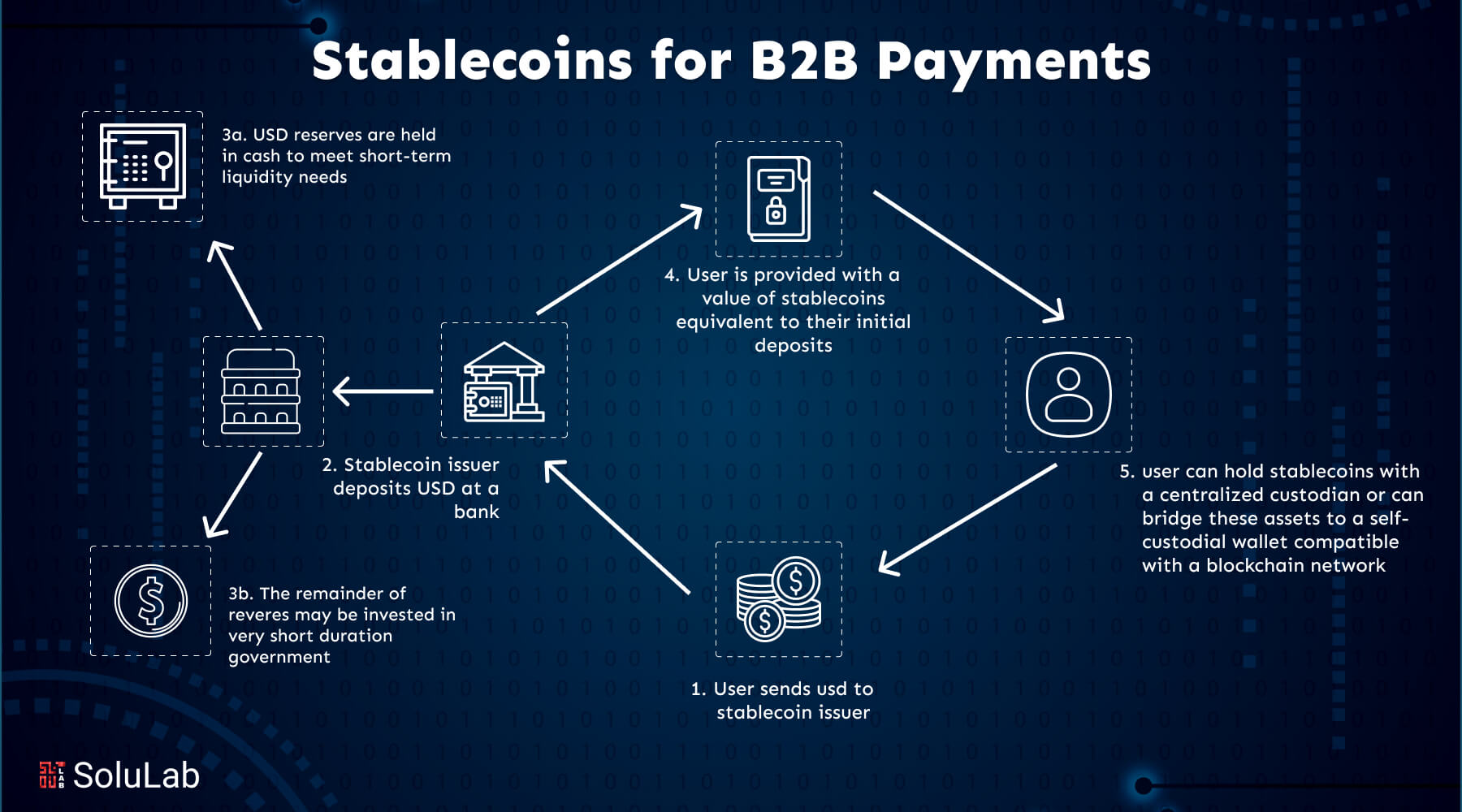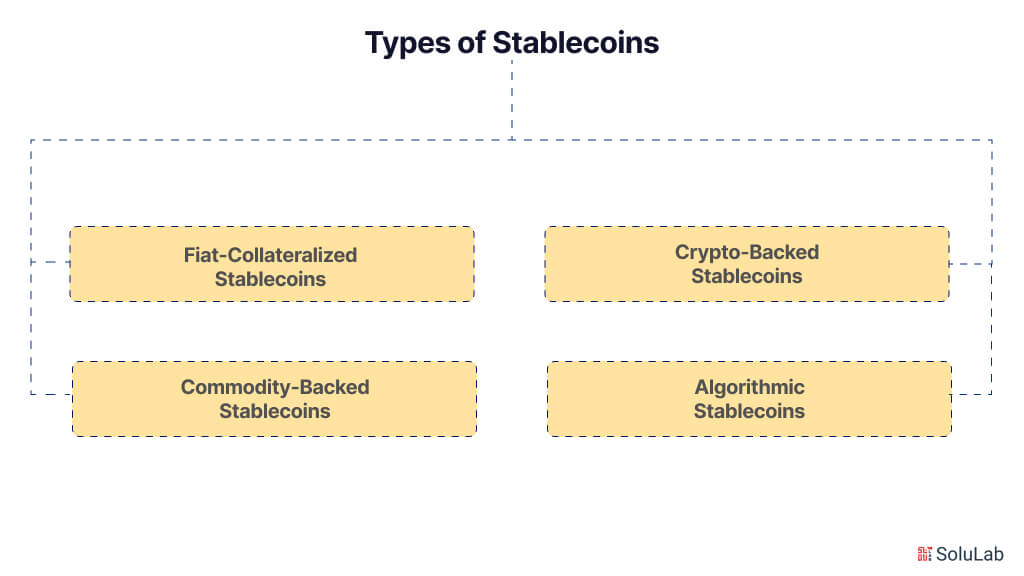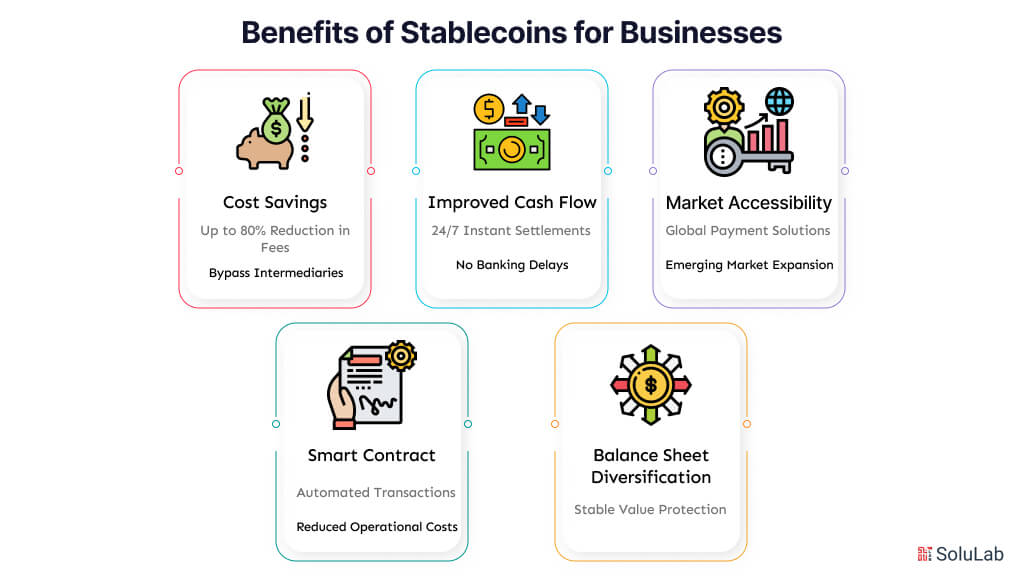
Businesses require safe, effective, and transparent methods of payment in the current worldwide economy. High fees, delays, and complexity are common examples of inefficiencies in traditional cross-border transactions. Because they provide stability, quicker processing times, and lower prices without the volatility issues that other cryptocurrencies have, stablecoins have become extremely useful instruments for business-to-business (B2B) payments.
Additionally, stablecoin adoption has increased by 30%, and its transaction volume has surpassed Visa’s in Q1 2025. Payment processors say that stablecoins currently make up about 60% of all cryptocurrency payments, and enterprise adoption continues to grow as big businesses like SAP test cross-border payments utilizing stablecoins.
This article looks at the top stablecoins that will improve business-to-business payments in 2025, as well as their benefits, ways your company may use them to run more smoothly. Let’s begin!
How Stablecoins Work for B2B?
Stablecoins are impacting B2B payments by providing a fast, secure, and cost-effective alternative to traditional payment methods. Unlike volatile cryptocurrencies, stablecoins maintain a consistent value, making them ideal for business-to-business (B2B) transactions. Through stablecoin-based B2B payment systems, businesses can streamline cross-border payments, reduce transaction fees, and avoid delays often associated with traditional banking.
Here’s how stablecoins work for B2B:
1. Instant Settlements: With a stablecoin payment gateway for B2B, transactions settle in real-time, eliminating delays in payment processing and improving cash flow management.
2. Lower Transaction Costs: Stablecoin payments bypass intermediaries like banks, reducing transaction fees and ensuring cost savings for businesses.
3. Global Accessibility: Stablecoin integration for businesses enables seamless cross-border payments without the hassle of currency exchange or high conversion rates.
4. Transparency and Security: Transactions are recorded on the blockchain, offering complete transparency, traceability, and robust security for B2B payments.
5. Simplified Integration: Businesses can easily integrate stablecoin solutions into their existing systems, providing a smooth transition to modern payment infrastructure.
By adopting stablecoin-based payment systems, businesses can enhance operational efficiency, minimize costs, and facilitate secure, scalable B2B transactions globally.
Types of Stablecoins

Stablecoins are digital currencies that operate within the blockchain ecosystem. They can be categorized based on their collateral structures, which determine their stability and use cases. Understanding these types of stablecoins helps businesses make informed decisions when exploring why businesses use stablecoins for payments, investments, and operational efficiency.
1. Fiat-Collateralized Stablecoins
Fiat-collateralized stablecoins are the most common and straightforward type of stablecoin. These stablecoins are backed by fiat currencies such as the US Dollar, Euro, or GBP on a 1:1 ratio. This means that for every stablecoin issued, an equivalent amount of fiat currency is held in reserve.
The simplicity of fiat-backed stablecoins makes them ideal for businesses and beginners exploring why businesses use stablecoins. Their stability is tied to the strength of the fiat currency and the underlying economy, ensuring minimal price fluctuation. This stability promotes confidence and encourages broader adoption of stablecoins.
2. Commodity-Backed Stablecoins
Commodity-backed stablecoins are supported by interchangeable physical assets, such as precious metals (e.g., gold), real estate, or oil. With commodity-backed stablecoins, users essentially own tangible assets with intrinsic value. These stablecoins allow investors worldwide to access commodities traditionally reserved for high-net-worth individuals, such as gold or real estate, providing a democratized investment opportunity.
For example, Digix Gold (DGX) represents one gram of physical gold held in a reserve in Singapore. Businesses may adopt commodity-backed stablecoins to hedge against market volatility and benefit from asset appreciation, further supporting why businesses use stablecoins.
3. Crypto-Collateralized Stablecoins
Crypto-backed stablecoins may seem counterintuitive due to the volatility of cryptocurrencies. However, these stablecoins achieve stability through over-collateralization. Businesses can lock in cryptocurrency (e.g., Ether) worth more than the value of the issued stablecoins to absorb potential price fluctuations.
For instance, if $1,000 worth of Ether is deposited to issue $500 worth of stablecoins, the over-collateralization ensures stability even if the price drops by 25%. In cases of extreme price drops, the stablecoin system triggers liquidation to maintain value. Crypto-collateralized stablecoins are fully decentralized, making them ideal for businesses prioritizing security, transparency, and trustlessness.
4. Algorithmic Stablecoins
Algorithmic stablecoins are unique as they are not backed by any collateral. Instead, they rely on algorithms to control the supply and demand of stablecoins, maintaining price stability. This model, also known as “seigniorage shares,” ensures that new coins are created when demand increases to lower prices, and coins are bought back to reduce supply when prices fall.
Their success depends on consistent market growth and liquidity. If market conditions fail, algorithmic stablecoins can collapse, leading to significant losses. Businesses exploring why businesses use stablecoins might consider algorithmic models for their decentralization and independence, but these require careful risk assessment.
By understanding the various types of stablecoins, businesses can identify the most suitable options for payments, investments, and operational efficiency. Stablecoins offer stability, transparency, and cost-effectiveness, which are critical reasons why businesses use stablecoins in modern financial systems.
Read More: Dollar-to-Stablecoin Swaps In White-Label Neo Banking
Best Stablecoins for Businesses
When it comes to using stablecoins in business operations, selecting the right stablecoin is crucial for ensuring stability, security, and efficiency. Stablecoins can simplify cross-border payments, reduce transaction costs, and improve financial processes, which is why they are increasingly adopted by enterprises. Here are some of the best stablecoins for businesses:
-
USDC (USD Coin)
USDC is a fiat-collateralized stablecoin backed 1:1 by the US Dollar. It is one of the most trusted stablecoins, widely adopted by businesses for B2B payments and cross-border transactions. With regular audits and high transparency, USDC ensures reliability and security, making it an excellent choice for companies seeking stable digital payments.
-
USDT (Tether)
Tether (USDT) is another leading fiat-backed stablecoin pegged to the US Dollar. It is widely used in business transactions due to its high liquidity and compatibility across multiple blockchain networks. For businesses looking to implement a stablecoin payment gateway for B2B, USDT offers speed, low fees, and extensive market acceptance.
-
DAI
DAI is a crypto-backed stablecoin maintained by the MakerDAO system. It is over-collateralized with various cryptocurrencies, ensuring decentralization and transparency. Businesses exploring decentralized solutions can use DAI for cross-border payments or integrate stablecoin solutions without reliance on traditional financial systems.
-
BUSD (Binance USD)
BUSD is a fiat-collateralized stablecoin regulated and approved by financial authorities, offering strong credibility for businesses. Its integration with the Binance ecosystem makes it ideal for enterprises seeking stablecoin integration for businesses that require scalability, compliance, and fast settlements.
-
PAX Gold (PAXG)
PAXG is a commodity-backed stablecoin pegged to physical gold. Businesses can leverage PAXG for secure, tangible value storage or as a hedge against economic instability. For enterprises dealing with international trade or wealth preservation, PAXG provides unique opportunities to integrate stable, asset-backed digital payments with the help of asset-backed stablecoins.
-
EUROC (Euro Coin)
For businesses operating in Europe or dealing with Euro-based transactions, EUROC offers a reliable fiat-backed stablecoin pegged to the Euro. It simplifies transactions within the European market while reducing the complexities of currency conversions.
How Stablecoin Development Enhances B2B Payment Systems?
Stablecoin development is transforming the way businesses handle B2B payments by providing faster, cost-effective, and secure financial solutions. With the limitations of traditional banking systems—such as high transaction fees, lengthy settlement times, and currency conversion challenges—stablecoin-based systems offer a modern alternative that aligns with global business demands.
Here’s how AI stablecoin development supports B2B payments:
1. Instant Cross-Border Transactions: Stablecoins enable real-time settlements across borders, eliminating delays caused by intermediaries. Businesses can transfer funds instantly, improving cash flow and operational efficiency.
2. Lower Transaction Costs: Traditional payment systems often involve high fees for international transactions. AI-powered stablecoin development reduces these costs by cutting out banks and intermediaries, making B2B payments more affordable.
3. Stability and Predictability: Unlike volatile cryptocurrencies, stablecoins maintain a consistent value, ensuring businesses can rely on them for predictable and stable financial transactions. This makes them ideal for long-term agreements and recurring payments.
4. Seamless Integration: Stablecoin integration for businesses allows enterprises to incorporate stablecoin solutions into existing financial systems or ERPs, providing a smooth and scalable transition to blockchain-based payments.
5. Transparency and Security: Stablecoins operate on blockchain technology, ensuring every transaction is recorded securely and transparently. Businesses benefit from enhanced trust and traceability, reducing risks of fraud.
6. Improved Liquidity: Stablecoins offer businesses access to instant liquidity without waiting for bank approvals, helping enterprises manage operations more efficiently.
By using a stablecoin payment gateway for B2B, stablecoin in DeFi, and tailored stablecoin-based B2B payment systems, businesses can streamline their payment processes, save on operational costs, and ensure faster, more reliable transactions. As stablecoin development evolves, it is set to redefine the future of B2B payments, delivering unparalleled efficiency and global accessibility.
Benefits of Stablecoins for Businesses

Stablecoins are becoming a popular choice for businesses seeking speedier, more cost-effective, and dependable payment options. Digital currencies, which are based on blockchain technology, alleviate many of the problems that traditional financial systems face, including high transaction costs, inefficient settlement times, and limited accessibility.
Here are the key benefits of stablecoins for businesses:
1. Cost Savings: Leading stablecoins operate on decentralized blockchains, enabling businesses to bypass traditional intermediaries, expensive currency conversions, and stringent compliance-related costs. Even when bridging fiat transactions through third parties, significant savings are achievable. For instance, moving funds from Southeast Asia to Europe can be 3-4 times cheaper than using the SWIFT network, while transfers from Africa to Europe can cost 5-10 times less.
2. Improved Cash Flow: Cash flow is a critical challenge for businesses, and slow payment settlement aggravates the issue, especially for cross-border transactions due to foreign exchange (FX) delays. In contrast, stablecoins operate 24/7, free from such bottlenecks, enabling near-instant settlements. This ensures businesses have the working capital they need, improving financial planning and operational efficiency.
3. Market Accessibility: Stablecoins offer a secure alternative payment method in areas with weak banking infrastructure or limited access to standard banking services. Businesses selling into emerging nations gain from enhanced payment methods, while local consumers have access to a broader range of goods and services. This greater market reach promotes growth and inclusivity.
4. Smart Contract Integration: Stablecoins are effortlessly integrated with smart contracts, which automate payment terms and circumstances. Smart contracts can help organizations streamline settlement processes, decrease manual errors, and cut operating costs. This automation ensures that payments are processed quickly, precisely, and with minimal administrative cost.
5. Balance Sheet Diversification: Stablecoins provide businesses with a stable and dependable alternative to fiat currencies, particularly in areas impacted by inflation, economic instability, or limited access to tier-1 currencies such as the US dollar. Businesses that hold stablecoins can protect their assets and diversify their balance sheets, assuring a reliable store of value and decreasing exposure to market volatility.
The adoption of stablecoins allows businesses to reduce costs, access new markets, and enhance liquidity, making them a transformative tool for global trade and operational efficiency.
How to Implement Stablecoin Payments for Your Business?
Adopting stablecoins for B2B payments can offer businesses faster transactions, reduced costs, and enhanced cross-border payment efficiency. However, transitioning to a stablecoin-based payment system requires a structured approach to ensure smooth integration and minimal risk. Here’s a step-by-step guide to help businesses get started with stablecoins for B2B payments:
1. Identify Business Use Cases
Before adopting stablecoins, businesses should evaluate where they can add value. Use cases may include cross-border payments, supplier settlements, employee payouts, or holding reserves as a hedge against inflation. Clearly identifying objectives will help align stablecoin adoption with business goals.
2. Choose the Right Stablecoin
Selecting the appropriate stablecoin is crucial. Businesses should consider factors such as:
-
Stability and collateral type (fiat-backed, crypto-backed, or commodity-backed).
-
Regulatory compliance in target regions.
-
Transparency and auditing of reserves.
Popular options like USDC, USDT, and DAI are widely adopted in stablecoin-based B2B payment systems due to their liquidity and reliability.
3. Partner with a Stablecoin Payment Gateway
Businesses need to integrate a stablecoin payment gateway for B2B transactions to send and receive payments. Payment gateways enable seamless integration with existing financial systems and provide secure wallet infrastructure. Platforms like Circle, Binance Pay, or BitPay offer robust solutions for B2B payments.
4. Ensure Regulatory Compliance
Stablecoin adoption comes with varying regulatory requirements across jurisdictions. Businesses must work with legal and compliance teams to ensure adherence to anti-money laundering (AML), know-your-customer (KYC), and tax regulations to avoid potential legal risks.
5. Set Up Secure Wallets and Infrastructure
To send, receive, and hold stablecoins, businesses must set up secure digital wallets. Options include custodial wallets (managed by third-party providers) or non-custodial wallets for greater control. Ensuring wallet security through encryption and multi-signature authentication is critical for minimizing fraud risks.
6. Educate Teams and Partners
Businesses should train their internal finance teams and partners on the use of stablecoins and blockchain-based payment systems. Education ensures smooth adoption, helps mitigate errors, and promotes confidence in stablecoin-based B2B payment systems.
7. Pilot and Scale Gradually
Start with a small pilot program to test the use of stablecoins in a controlled environment. Monitor performance, security, and cost savings before scaling up to include more partners and transactions.
By following these steps, businesses can successfully integrate stablecoin development for B2B payments into their financial processes. This transition not only enhances efficiency but also positions businesses to capitalize on the advantages of blockchain-based payment systems.
Conclusion
Stablecoins are changing B2B payments by offering businesses faster transactions, lower costs, and greater global accessibility. By carefully selecting the appropriate stablecoin, establishing technical infrastructure, and addressing regulatory considerations, businesses can use these digital assets to gain a competitive edge in the global marketplace.
As the ecosystem matures and regulatory frameworks become clearer, stablecoins are poised to become a standard component of corporate treasury and payment operations, particularly for businesses engaged in international commerce.
Crypto Mining partnered with SoluLab to develop a decentralized e-commerce platform for mining hardware. Key features included a mining pool, an advanced mining farm, a profitability calculator, real-time monitoring, and enhanced security measures. The result was a user-friendly, scalable solution providing global miners seamless access to authentic mining devices and hosting services.
If you’re looking to optimize your B2B payment operations with stablecoins, SoluLab, a Stablecoin development company, offers comprehensive solutions. Contact our team today to help you discuss all your queries!
FAQs
1. What are stablecoins, and how do they differ from traditional cryptocurrencies?
Stablecoins are a type of cryptocurrency designed to maintain a stable value, usually pegged to a fiat currency or another asset. Unlike traditional cryptocurrencies like Bitcoin or Ethereum, which can be highly volatile, stablecoins offer price stability, making them ideal for business transactions that require predictable valuations.
2. What advantages do stablecoins offer for B2B payments?
Stablecoins offer several advantages for B2B payments, including lower transaction fees compared to traditional banking methods, faster transaction processing times (especially for international payments), and reduced currency risk due to their stable value. Furthermore, stablecoins can enhance security and transparency in transactions due to the underlying blockchain technology.
3. How can businesses integrate stablecoins into their payment systems?
Businesses can integrate stablecoins by choosing a stablecoin that best fits their needs, setting up a digital wallet to manage their holdings, and partnering with payment processors that support stablecoin transactions. It’s also essential to establish clear guidelines for using stablecoins within your accounting and financial systems to ensure compliance and ease of use.
4. Are there any risks associated with using stablecoins for B2B payments?
While stablecoins offer many benefits, there are some risks to consider. These include regulatory uncertainties, potential liquidity issues, and the necessity for adequate security measures to protect digital assets. Companies should conduct thorough research and consultations to understand the landscape and make informed decisions before adopting stablecoins.
5. How can I find a reliable partner for stablecoin development and integration?
To find a reliable partner for stablecoin development, it’s crucial to look for companies with a strong track record in blockchain technology and expertise in the financial sector. Reading reviews, assessing portfolios, and verifying technical capabilities can help. SoluLab, for example, is a leading stablecoin development company that can assist in creating tailored solutions to enhance your B2B payment processes. Contact us to learn more about how we can support your transition to stablecoin utilization.





